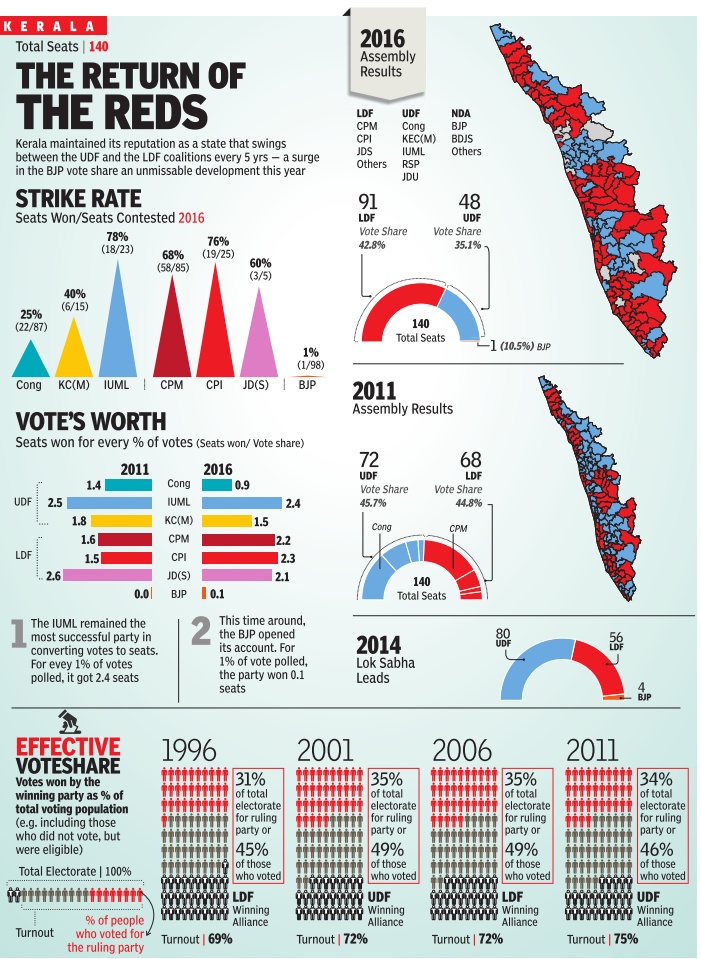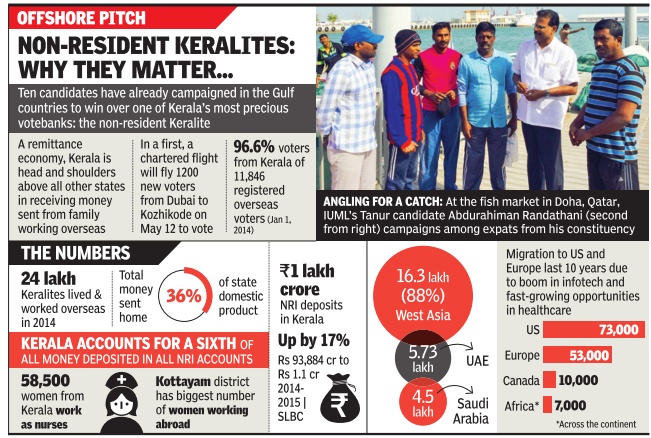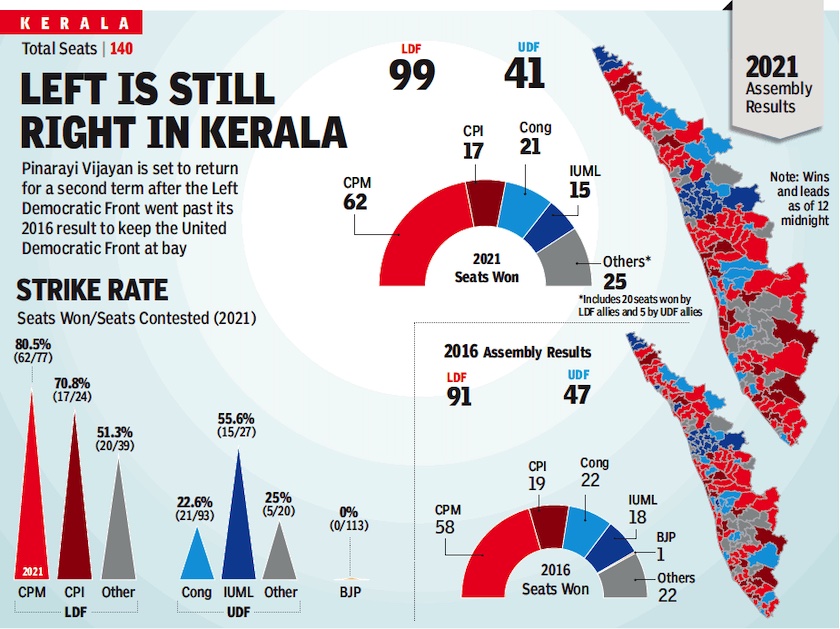Kerala: Assembly elections
This is a collection of articles archived for the excellence of their content. |



Contents |
History
Women candidates, voters, winners: 1957-2021
Sudha Nambudiri, May 3, 2021: The Times of India
See graphic:
Women candidates, voters, winners in the Kerala:_Assembly_elections: 1957-2021
Poor women representation in main political parties was a much-discussed issue in this . The new assembly will have 11 women MLAs led by health minister K K Shailaja.
For the first time since 1996 when there were 13 women MLAs, Kerala’s legislature will have a double-digit woman representation in the state in the assembly. This time there will be 10 ruling-party MLAs and one lone woman in the opposition, UDF-backed RMP’s K K Rema.
The winners include O S Ambika - Attingal, Veena George - Aranmula, CK Asha - Vaikom, J Chinchurani - Chadayamangalam, Daleema Jojo - Aroor, U Prathibha - Kayamkulam, R Bindu - Irinjalakuda, K Shantakumari - Kongad and Jameela Kanathil - Koyilandy.
Interestingly, of the 103 women who contested, 17 women candidates came as runner-up, indicating that the LDF wave led to their losses and they were closely-fought wins in many constituencies. Among the big losers are Shanimol Usman, Bindu Krishna, Shoba Surendran, P K Jayalakshmi and Padmaja Venugopal who kept the fight close. It is expected that there would be 2-3 women ministers. Shailaja has already proved her mettle. C K Asha and Veena George could be the other two candidates.
While there is not likely to be a sea change in women-centric policies of the LDF government, it is expected that Pinarayi Vijayan will give adequate importance to this voter segment who have voted for the front in large numbers.
“More than other parties, Left has groomed its women leaders from grassroot level. Since the present government has already announced much of its welfare programmes which is expected to continue, one can expect something for the women voters from the new government,” opined D Dhanuraj, chairman-CPPR.
The 2016 verdict vs. 2011
The Times of India, May 20 2016
Kerala's historic verdict ensured continuity of its patent ed bipolar politics by showing scam-ridden United Democratic Front (UDF) the door and giving an impressive mandate to CPM-led Left Democratic Front (LDF), but simultaneously signalled radical change by providing BJP a beachhead and ending decades of electoral untouchability .
The LDF won 91seats with a vote share of 42.6% , a fall by almost 3% from 2011, while the UDF had to be content with 47 seats and a vote share of 38.18%, a slide of almost 7%. The BJP managed to win just one seat, at Nemom in the capital district, where veteran O Rajagopal won by a convincing margin of 8,671votes.
Though none of the NDA partners fared well individually, BJP's candidates came a close second in seven seats and decided the outcome in as many as 30. Most crucially , they nearly tripled their vote share from 6% (when they contested as a single party) in 2011 to 15.5% (as part of the NDA) in 2016.
The LDF was ecstatic following the results with CPM veteran V S Achuthanandan, a CM aspirant, interpreting it as “a verdict against the UDF government, which blindly followed the `anti-people' policies of the Narendra Modi government at the Centre. It is also a verdict against a government which failed to give protection to the women in the state“.
The LDF's victory has been a virtual repeat of 2006 but the comparison ends there, because this time it was not just anti-incumbency .
The rise of the BJP-led NDA played a significant role in the extent of the LDF win. This consolidation was evident in the gains that the LDF made in the erstwhile Malabar districts like Malappuram, Kozhikode and Kannur, where the Muslims have a substantial presence.
Interestingly , the LDF benefitted from the NDA's looming presence indirectly too, with most of the Ezhava votes corralled by the BJP's main ally BDJS, cutting into UDF's support base. The LDF sweep in Kollam and Thrissur districts -winning all 11 seats in the former, and 12 of 13 in the latter -appeared to confirm this.
The NDA's performance also seemed to underscore the fact that while the BDJS and sundry smaller parties did definitely bring in votes, it was BJP's cachet of a national party , and especially one on the ascendant across India, that was the true allure for hitherto uncommitted voters.
The UDF had banked on its controversial new liquor policy that aimed at phased prohibition as a sure-shot votepuller, particularly among women and the Christians, and it was one legacy that the Oommen Chandy government hoped would compensate for all its misdemeanours. But apparently it had hoped too much. Excise minister K Babu, Chandy's main lieutenant and one of the main faces of the bar bribery scam, lost in Thripunithura by 4,467 votes, a constituency considered his fief.
Similar voter ambiguity was reflected on the issue of `corruption'. But former finance minister K M Mani, the target of LDF ire for his alleged money-making penchant, suffered some anxious moments but finally coasted through from Pala.
In the end, if it was a hardearned victory for the LDF, it was an emotionally more momentous one for the BJP. As Rajagopal put it, “Everyone, including CPM and Congress, was saying that BJP will not open its account in Kerala... A K Antony ridiculed us by saying that the only way BJP can enter the assembly is by taking a visitor's pass.“
2021
LDF wins second time in a row
May 3, 2021: The Times of India

From: May 3, 2021: The Times of India
After 44 Yrs, State Picks Repeat Over Reboot
Pinarayi Vijayan-Led LDF Wins 99 Seats In 140-Member Assembly, UDF Reduced to 41 (Cong 21), BJP Back To Zero
Thiruvananthapuram:
The ruling Left Democratic Front in Kerala won a historic second term in office, thanks to its level-headed and scrupulous management of the pandemic and CM Pinarayi Vijayan’s ability to withstand everything that a strident and combined Congress-BJP opposition threw at him. Vijayan’s no-nonsense attitude and ability to take risks earned him the sobriquet ‘captain’, though within his own party it led to some restiveness on what it possibly portended.
Although widely expected to return, the scale of LDF’s victory defied expectations --the front won 99 seats of the total 140, against 41 by the Congress-led United Democratic Front. The NDA, led by BJP, failed to gain any seats, and lost the sole Nemom seat it had in the previous assembly.
By focusing on his government’s track record of development and emphasising its secular credentials, Vijayan managed to neutralise the opposition’s persistent attack on him and his government in relation to various graft cases, ranging from gold smuggling, ‘backdoor government appointments’ and the alleged move to open up deep sea fishing for multinational companies. BJP tried to revive the contentious Sabarimala issue, and was ably seconded by Congress, but that too failed to make any dent. By deftly declaring that his government was willing to abide by whatever the Supreme Court decided, he preempted the opposition from cornering him on the issue.
Along with LDF’s increased tally, CPM too improved its share this time — from 63 seats in 2016 to 68, while CPI, the second largest constituent in LDF, won 17 seats, two less than in 2016. The loss of seats for allies CPI and JD(S) was in fact compensated by the entry of Kerala Congress(M). Vijayan himself acknowledged this at the post-results news conference, saying KC(M) has contributed significantly to the LDF’s emphatic victory.
UDF, on the other hand, dropped six seats from its tally last time. Congress could retain its 22 seats while IUML got only 14 seats, four less from 2016. The other constituents could together contribute only five seats to the front this time, against six won by KC (M) last time. In his initial reaction to the poll results, opposition leader Ramesh Chennithala said the UDF would continue to keep a tab on the government. “We always tried to expose the follies of the government and we will continue to do so,” he said.
More than the failure of the state leadership, the defeat is a severe setback for the AICC and particularly Rahul Gandhi who has been singlehandedly dictating things, right from the selection of candidates to campaigning. A bevy of AICC leaders had camped in the state for months to screen candidates and monitor campaigning. The party had believed in cashing on the anti-incumbency wave, and the majority and minority vote bank. But nothing worked in their favour as the people reposed their faith on Vijayan. It has to be believed Congress failed to read the writing on the wall.
BJP draws a blank but no.2 in 8 seats
Rajeev KR , May 3, 2021: The Times of India
BJP drew a blank in the Kerala assembly elections, failing to retain even Nemom, which party leaders often referred to as “BJP’s Gujarat in Kerala”. What could offer some solace is that the party finished second in 8 seats.
At Manjeswaram in Kasaragod, where party state president K Surendran put up a strong fight, it lost by a narrow margin of 745 votes to the Indian Union Muslim League candidate.
Apart from Manjeswaram, Surendran contested from Konni in Pathanamthitta. The leader who was also the face of BJP during the Sabarimala agitations was relegated to third position in the constituency where the temple is situated.
At Kazhakkoottam, where BJP’s Sobha Surendran raised the issue aggressively against sitting MLA and devaswom minister Kadakampally Surendran, BJP finished second. The minister retained the seat by 23,497 votes.
However, the real jolt came from Nemom where BJP won for the first time in 2016. Nemom had emerged as a major arena even before campaigning had begun. In the tightly-contested fight, former CPM MLA from Nemom V Sivankutty defeated BJP’s Kummanam Rajasekharan by over 5,750 votes.
The last iota of hope was with ‘Metro Man’ E Sreedharan in Palakkad but the 88-year-old technocrat lost to sitting Congress MLA Shafi Parambil by 3,863 votes.
Muslim, Christian voters turned to LDF
Rajeev KR & Jaikrishnan Nair, May 3, 2021: The Times of India
Ever since the cobbling together of United Democratic Front (UDF) in Kerala in 1970 in the lone Christian pocket in Muslim-majority Malappuram, the front has become the political platform for minority communities that amount to 45% of the electorate.
The political experiment helped shape UDF’s rainbow political base, bringing together the bulk of Muslims mostly concentrated in Malabar (26.6% as per 2011 census) and Christians based in central Kerala (18.4%) and aligning them with Congress’ traditional anti-Marxist vote base spread across various communities. This political experiment was key to Kerala’s four-decade-old alternating LDF and UDF regimes. This time, LDF managed to make inroads into what UDF had considered as its electoral fixed deposits.
Among the 66 assembly constituencies where Muslim votes play a decisive role in determining the winner, LDF was able to win 45 seats. Even IUML took a beating with its tally coming down from 2016. Of the 21 seats won by UDF where Muslim votes are decisive, 20 are in Malabar; reflecting the Muslims vote consolidation behind LDF especially in central and south Kerala, where they had to choose between Congress and LDF. LDF seems to have sensed minorities warming up to it and was enthusiastic in supporting the mass agitations against CAA/NRC. It put out full-page advertisements exclusively in Muslim-management run newspapers on April 6, polling day, proclaiming the front will not implement CAA/NRC and that there won’t be any detention camps in state.
Also LDF’s big win cannot be possible without the support of the church, especially in central Kerala. And this hasn’t happened overnight. The church was agitated for some time with UDF for the prominence it gave to IUML.
The speech made by Oommen Chandy’s son, regarding conversion of Hagia Sophia into a mosque in Turkey, did not go well with the church and its bishops. The stand of Jacobite Church made Chandy sweat though he won Puthuppally. Though Jacobite church leaders met BJP ahead of the elections, they went back to LDF at the last minute.